Table of Contents
Introduction
Aerial Imaging Statistics: Aerial imaging, is a method of capturing photographs or videos from airborne platforms. Ranging from aircraft and drones to satellites provide unique comprehensive views crucial for diverse applications such as agriculture, urban planning, and disaster management.
Utilizing high-resolution cameras and advanced sensors, it offers detailed analyses of large areas impossible to achieve from ground level.
While it presents numerous advantages like extensive coverage and flexibility in use, challenges. Regulatory restrictions, privacy concerns, and weather dependency, also persist.
With its growing importance across various sectors, aerial imaging continues to evolve. Promising enhanced data accuracy and broader application possibilities in the future.
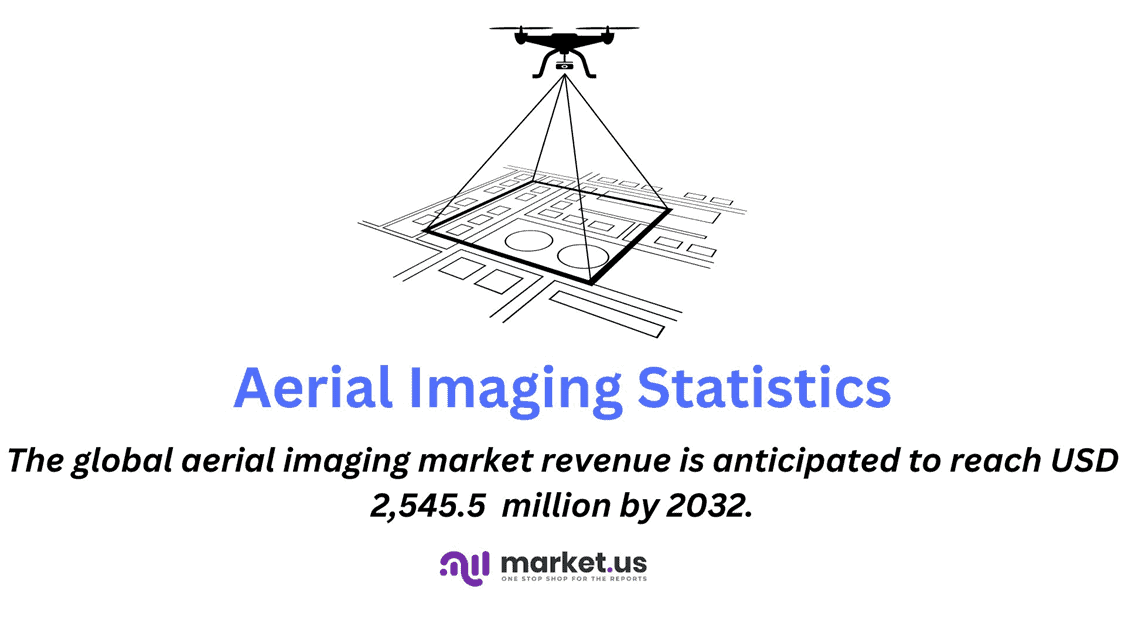
Editor’s Choice
- The global aerial imaging market revenue is projected to reach USD 2,545.5 million by 2032.
- In terms of market share distribution, North America dominates the global aerial imaging market with a commanding share of 47.3%, followed by Europe at 24.6%.
- Among companies, AeroMetric Inc. holds the largest market share at 15%.
- For standard drone hire, clients can expect rates to fall between $200 and $1,300.
- Neurotechnology, in collaboration with SmartField, has launched DroneScope, an innovative solution merging computer vision and drone technologies for agriculture.
- The drone market funding was valued at USD 1,678 million in 2023.
- By 2029, the U.S. military plans to allocate $2.7 billion toward drone research and development and $3.3 billion towards procurement. These figures may escalate further, considering potential additional funding earmarked for classified projects.
Aerial Imaging Market Statistics
Global Aerial Imaging Market Size Statistics
- The global aerial imaging market has exhibited a gradual increase in revenue from 2021 to 2032 at a CAGR of 14.5%.
- Starting with a revenue of USD 2,386.0 million in 2021. The market saw a modest rise to USD 2,400.5 million in 2022.
- This upward trend continued steadily through the years, with revenue reaching USD 2,415.0 million in 2023 and slightly rising to USD 2,429.5 million in 2024.
- By 2025, the market revenue was estimated at USD 2,444.0 million. Incrementally increasing to USD 2,458.5 million in 2026 and then to USD 2,473.0 million in 2027.
- The growth pattern persisted, with market revenue reaching USD 2,487.5 million in 2028 USD 2,502.0 million in 2029, and USD 2,516.5 million in 2030.
- The market is expected to continue its steady growth, with projections of USD 2,531.0 million in 2031 and USD 2,545.5 million by 2032, reflecting a consistent and stable expansion over the decade.
(Source: Market.us)
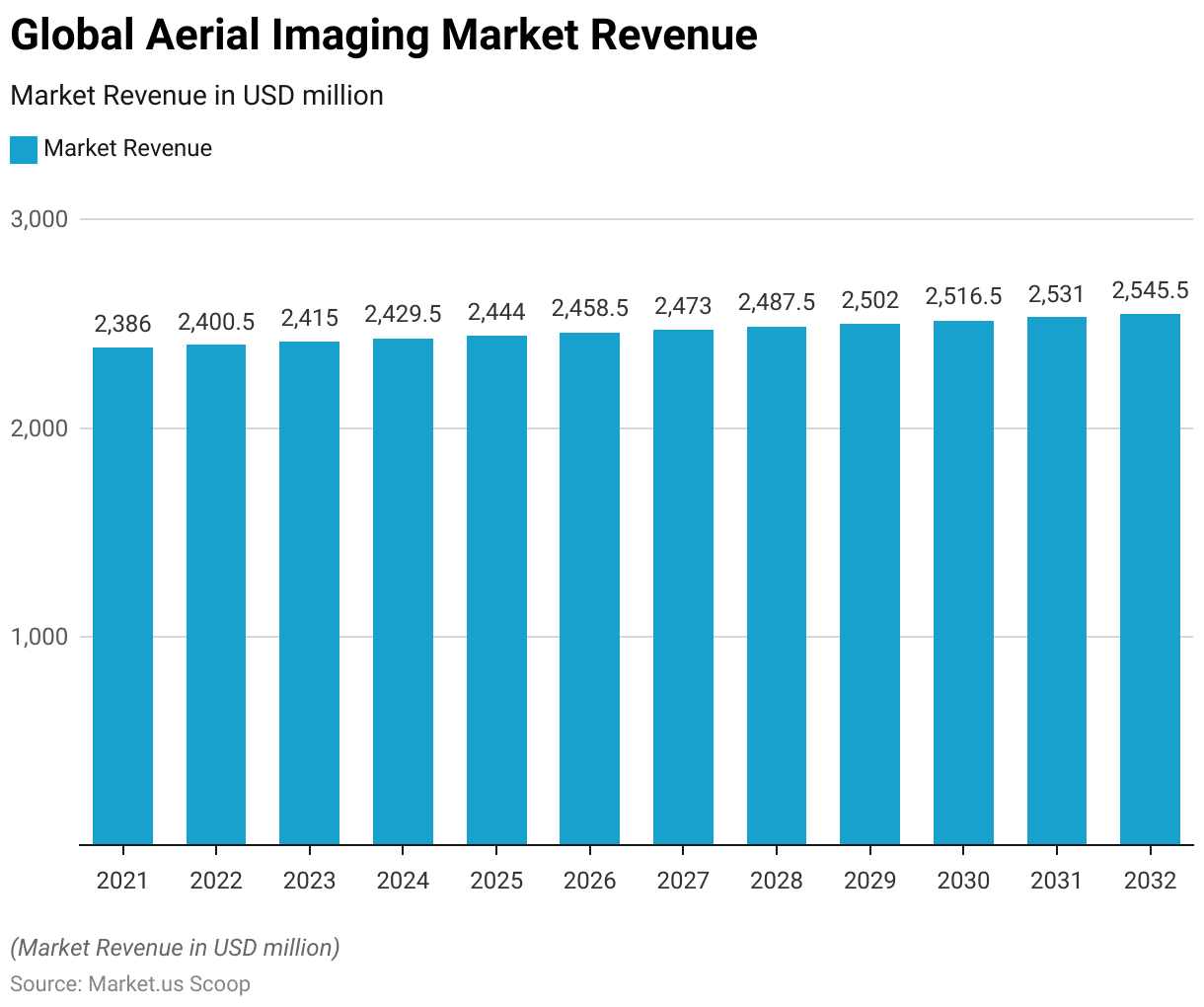
Regional Analysis of the Global Aerial Imaging Market Statistics
- In terms of market share distribution, North America dominates the global aerial imaging market with a commanding share of 47.3%, followed by Europe at 24.6%.
- The Asia-Pacific (APAC) region holds a significant portion of the market as well. Accounting for 21.0% of the total market share.
- Meanwhile, South America and the Middle East & Africa (MEA) regions have relatively smaller shares, with 5.0% and 2.1% respectively.
- This distribution highlights the strong presence of aerial imaging technologies in North America and Europe. Driven by factors such as advanced infrastructure, technological innovation, and widespread adoption across various industries.
- Despite the smaller shares of South America and MEA, there exists potential for growth as these regions continue to invest in infrastructure development and embrace aerial imaging solutions for applications ranging from urban planning to natural resource management.
(Source: Market.us)
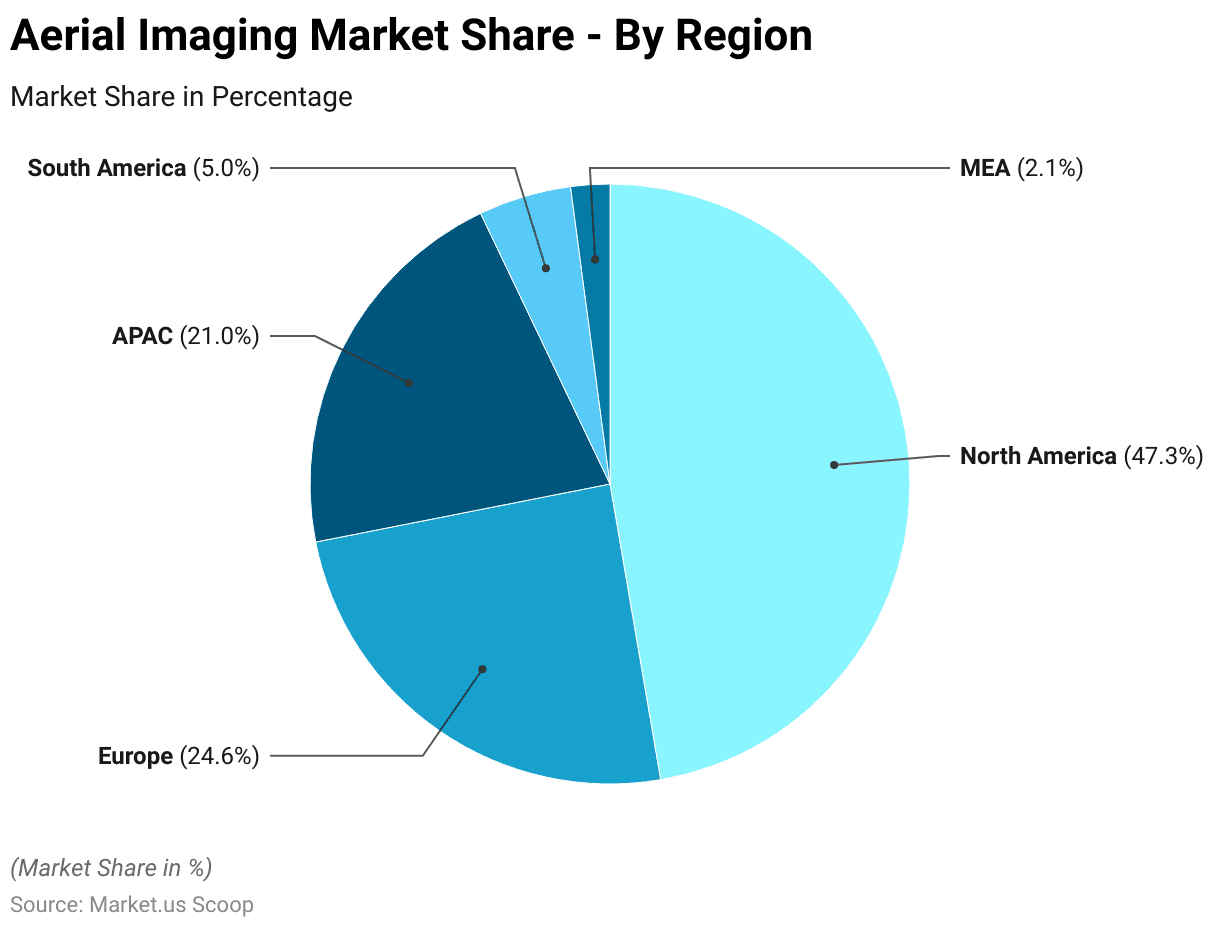
Competitive Analysis of the Global Aerial Imaging Market Statistics
- The aerial imaging market is characterized by a diverse range of key players. Each contributes to the industry’s landscape with varying market shares.
- Among these companies, AeroMetric Inc. holds the largest market share at 15%. Closely followed by Google Inc. at 14% and Eagle Aerial Solutions at 13%.
- Kucera International Inc. and Landiscor Aerial Information hold significant shares as well, accounting for 11% and 9%, respectively.
- Eagle View Technologies and NRC Group ASA each secure 9% and 8% of the market. While Digital Aerial Solutions holds a 7% share.
- Cooper Aerial Surveys maintains a smaller presence with 2% of the market.
- Additionally, other key players collectively contribute 12% to the market share.
- This distribution underscores the competitive landscape within the aerial imaging sector. With companies vying for market dominance through technological innovation. Strategic partnerships, and geographical expansion to meet the diverse needs of customers across industries.
(Source: Market.us)
Take advantage of our unbeatable offer - buy now!

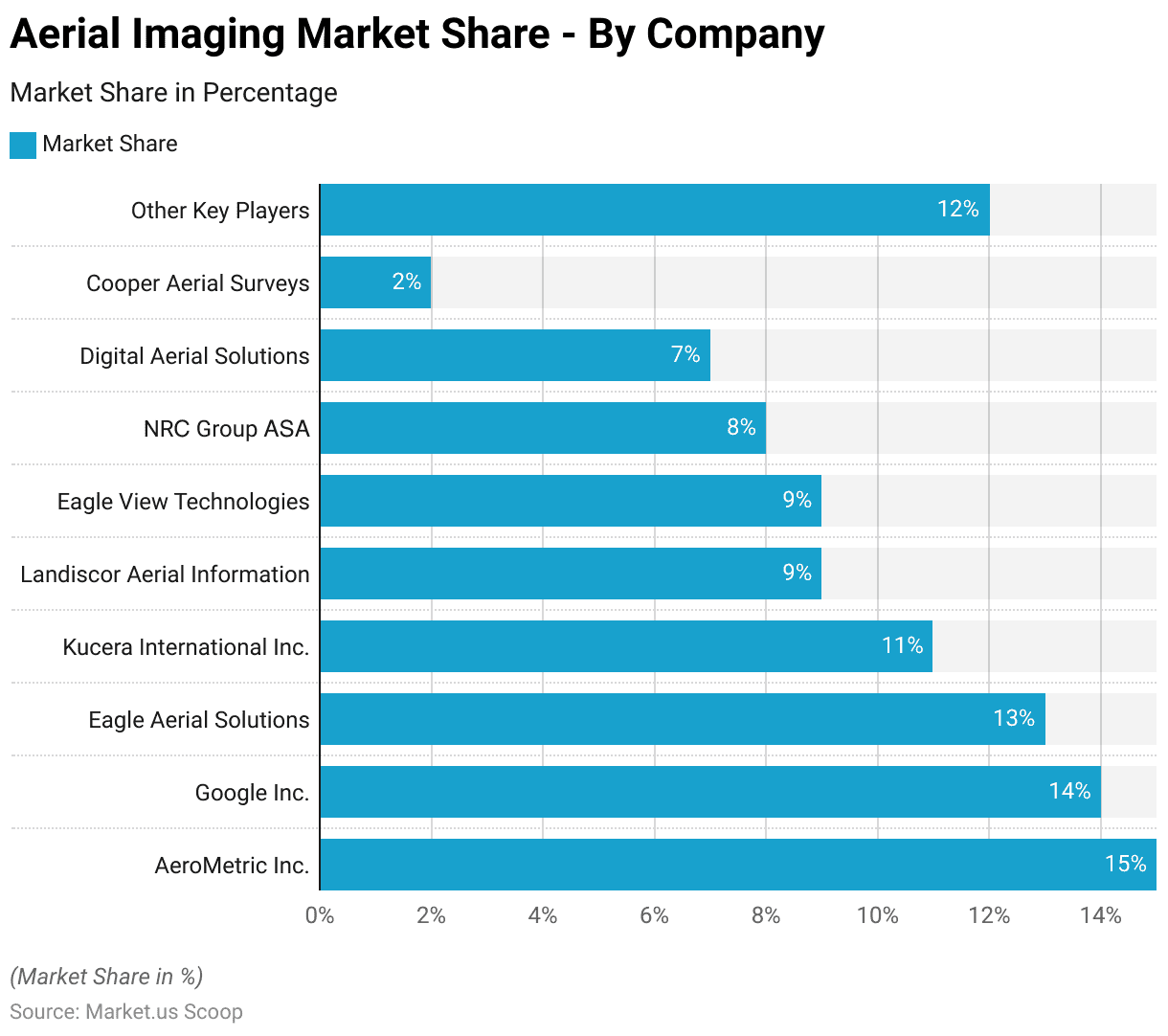
Cost of Aerial Imaging and Drone Photography Statistics
Average Cost of Aerial Imaging and Drone Photography Statistics
- In the realm of drone photography services, costs vary based on several factors.
- On average, clients can expect to pay around $100 per hour for drone photography sessions. This figure serves as a benchmark against which both minimum and maximum costs can be evaluated.
- At the lower end of the spectrum, some providers offer their services for as little as $70 per hour, providing a cost-effective option for budget-conscious clients.
- Conversely, at the higher end, premium services command rates of up to $250 per hour. Reflecting additional value propositions such as advanced equipment, expertise, or specialized techniques.
- These pricing parameters encapsulate the range of options available in the drone photography market. Catering to diverse needs and budgets while ensuring quality and professionalism across the board.
(Source: Bark)

Average Cost of Aerial Imaging and Drone Photography Based On the Type of Job Statistics
- The average cost of drone photography varies significantly depending on the type of job required, with prices ranging across different categories.
- For standard drone hire, clients can expect rates to fall between $200 and $1,300. With specialist drone hire commanding higher prices averaging between $2,100 and $5,400.
- Utilizing a blimp alongside a drone for aerial photography purposes typically incurs costs ranging from $600 to $1,225.
- Meanwhile, standalone aerial photography services without additional equipment generally range from $1,050 to $2,700.
- These price differentials reflect the specialized nature of each type of drone job, with factors such as the complexity of the project, equipment requirements, and expertise of the operator influencing the overall cost.
- Clients can select the appropriate service based on their specific needs and budget constraints. With providers offering transparent pricing structures to accommodate a diverse range of projects and requirements.
(Source: Bark)
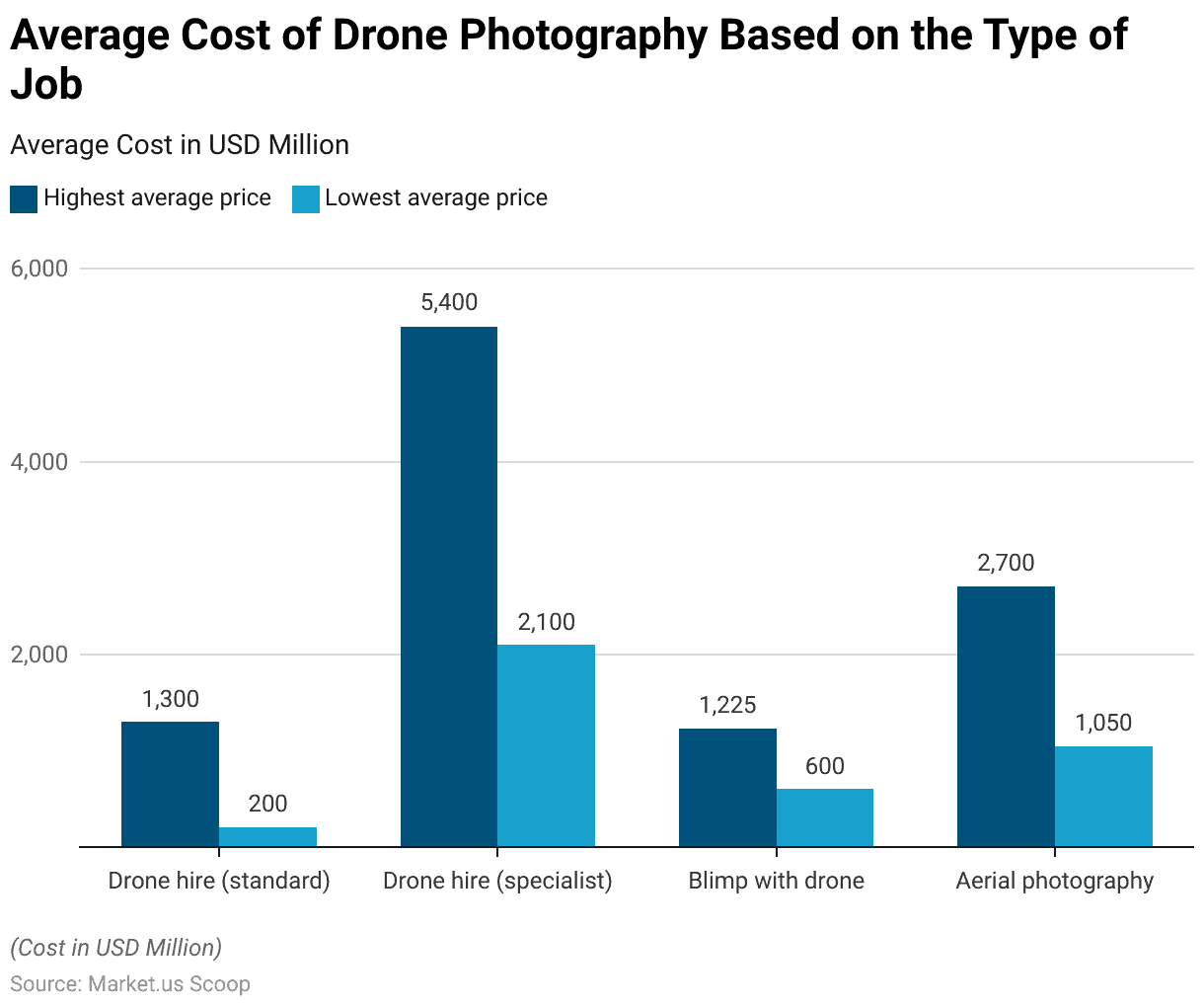
Average Cost of Aerial Imaging and Drone Photography Based On the Drone Model Statistics
- The average cost of drone photography rental varies depending on the specific drone model chosen for the job. For instance, renting a Mavic Pro typically costs around $665, while opting for a Phantom 4 involves an average rental fee of $800.
- Choosing the more advanced Inspire 1 Pro for aerial photography purposes comes with a slightly higher average rental cost of $880.
- However, for more specialized and professional-grade drone models like the Matrix 600. Clients can expect significantly higher rental prices, averaging around $3,400.
- These price differentials reflect the varying capabilities, features, and specifications of each drone model. With more advanced models offering enhanced performance and functionality at a premium cost.
- Clients can select the appropriate drone model based on their specific project requirements. Budget considerations, and desired level of quality and sophistication for aerial photography endeavors.
(Source: Bark)
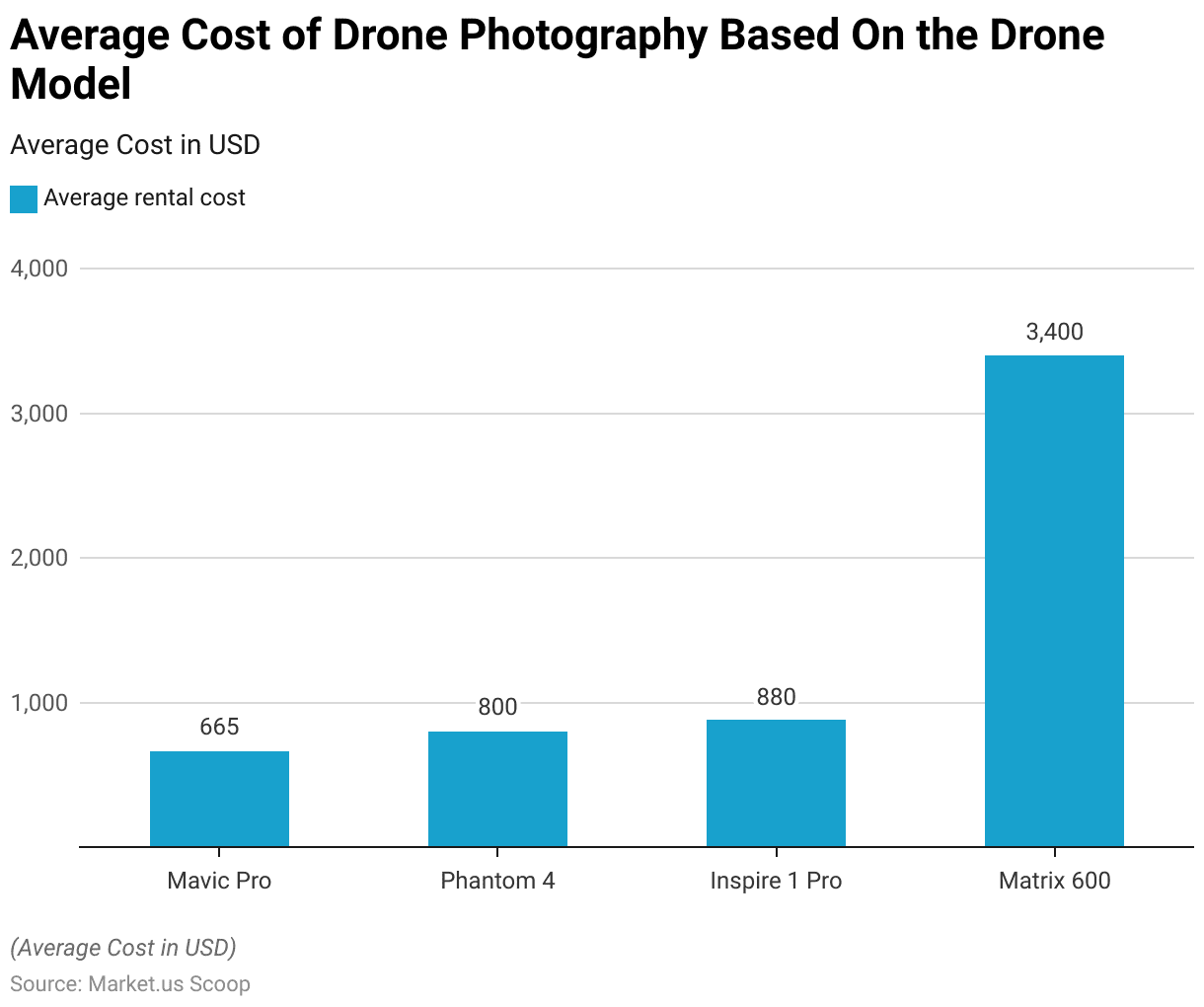
Current Technologies in Aerial Imaging Statistics
DroneScope Service and Solution
- Neurotechnology, in collaboration with SmartField, has launched DroneScope, an innovative solution merging computer vision and drone technologies for agriculture.
- Traditionally, expensive image acquisition and processing, particularly with agricultural drones, required specialized operators.
- DroneScope addresses this by utilizing RGB images from standard commercial drones under 900 grams. Equipped with 12-megapixel cameras and efficient object avoidance systems.
- This adaptability suits both small and large-scale agricultural needs.
- Its aerial imagery recognition algorithm allows farmers to swiftly and closely monitor crops. Surpassing satellite imagery in immediacy and boasting 100 times better survey capacity than humans. The algorithm ensures impartiality in sampling.
(Source: Neurotechnology)
AIR PIX Aerial Camera
- A leading figure in the aerial imaging sector, AirSelfie, unveiled the AIR PIX aerial camera during the Consumer Technology Association (CES) 2020 event.
- Recently, the company has commenced the distribution of AIR PIX+, touted as the world’s smallest pocket-sized aerial camera, to customers worldwide.
- Additionally, AirSelfie has announced plans to release AIR DUO, featuring dual parallel cameras, later in 2020.
- These cutting-edge cameras promise advanced technology and are poised to play a crucial role in aerial imaging and capturing airborne videos.
(Source: Lulop)
Skydio X2
- In July 2020, Skydio, a well-known U.S. drone manufacturer recognized for its proficiency in autonomous flight technology, revealed its latest product: The Skydio X2, designed specifically for enterprise and public sector uses.
- Alongside this release, Skydio introduced several new software solutions targeted at improving inspection procedures and bolstering situational awareness.
- These solutions encompass Skydio Autonomy Enterprise Foundation, Skydio 3D Scan, and Skydio House Scan.
- These software innovations, compatible with the Skydio 2 model as well, play a vital role in the company’s strategy for rapidly advancing its product lineup in the enterprise and government sectors.
- This announcement coincided with Skydio’s successful completion of a $100 million Series C funding round.
(Source: Skydio)
DJI’s P4 Multispectral drone
- DJI’s P4 Multispectral drone transforms farming by consolidating data from six sensors to evaluate crop health thoroughly. It assesses crops, including individual plants and entire fields, while also detecting weeds, insects, and diverse soil conditions.
- Equipped with a stabilized imaging system containing an RGB camera and a multispectral camera array with five narrow-band sensors, it captures both visible and invisible light. This data offers professionals vital insights into vegetation stress, soil composition, water salinity, and contamination.
- Additionally, an integrated spectral sunlight sensor enhances data collection accuracy and consistency across missions conducted at different times of the day.
- DJI unveiled DJI X-Port, a fresh gimbal add-on for DJI Matrice 200 Series V2 drones, broadening its assistance to non-professional drone users. X-Port facilitates the smooth integration of custom sensors by drone hardware developers.
- With built-in communication APIs, DJI SkyPort compatibility, and a gimbal debugging interface, X-Port speeds up sensor innovation development, potentially reducing development time by 40 percent.
(Source: DJI)
Telefónica Project
- In an initiative led by Telefónica and Correos, a pilot program was introduced in early 2023 in Spain, showcasing the first application of package delivery utilizing air traffic control of drones connected to 5G technology.
- This pilot involves the coordinated flight of multiple drones, communicating not only with each other but also with various urban infrastructure components.
- Its purpose is to facilitate drone package delivery to designated destinations, allowing drones to navigate through potential obstacles and restricted areas with the assistance of real-time warnings.
- The endeavor is a component of Telefónica’s 5G Madrid initiative, which falls under the umbrella of the Ministry of Economic Affairs and Digital Transformation’s call for 5G grants via Red.es.
- FEDER funds back this program and aims to foster innovation pilots utilizing 5G technology in Spain.
(Source: Telefónica)
Investments in Drone Technology
Global Drone Industry Funding
- The funding landscape for the drone industry has witnessed substantial growth over the past decade, with investments steadily increasing from 2014 to 2021.
- In 2014, funding stood at 303 million USD, which more than doubled by 2015, reaching 526 million USD.
- This trend continued in subsequent years, with 2016 seeing a further increase to 624 million USD and 2017 maintaining strong momentum at 548 million USD.
- The following years saw remarkable surges, particularly in 2018 and 2019, where funding reached 729 million USD and 1,162 million USD, respectively.
- The momentum persisted into the new decade, with 2020 and 2021 recording significant spikes, reaching 1,349 million USD and an impressive 3,540 million USD, respectively.
- However, the growth trajectory shifted in 2022 and 2023, witnessing a slight decline to 3,309 million USD and 1,678 million USD, respectively, marking a notable deviation from the previous upward trend.
- Despite this recent fluctuation, the drone industry remains a focal point for substantial investment, reflecting the continued confidence and potential for innovation within the sector.
(Source: Drone Industry Insights)
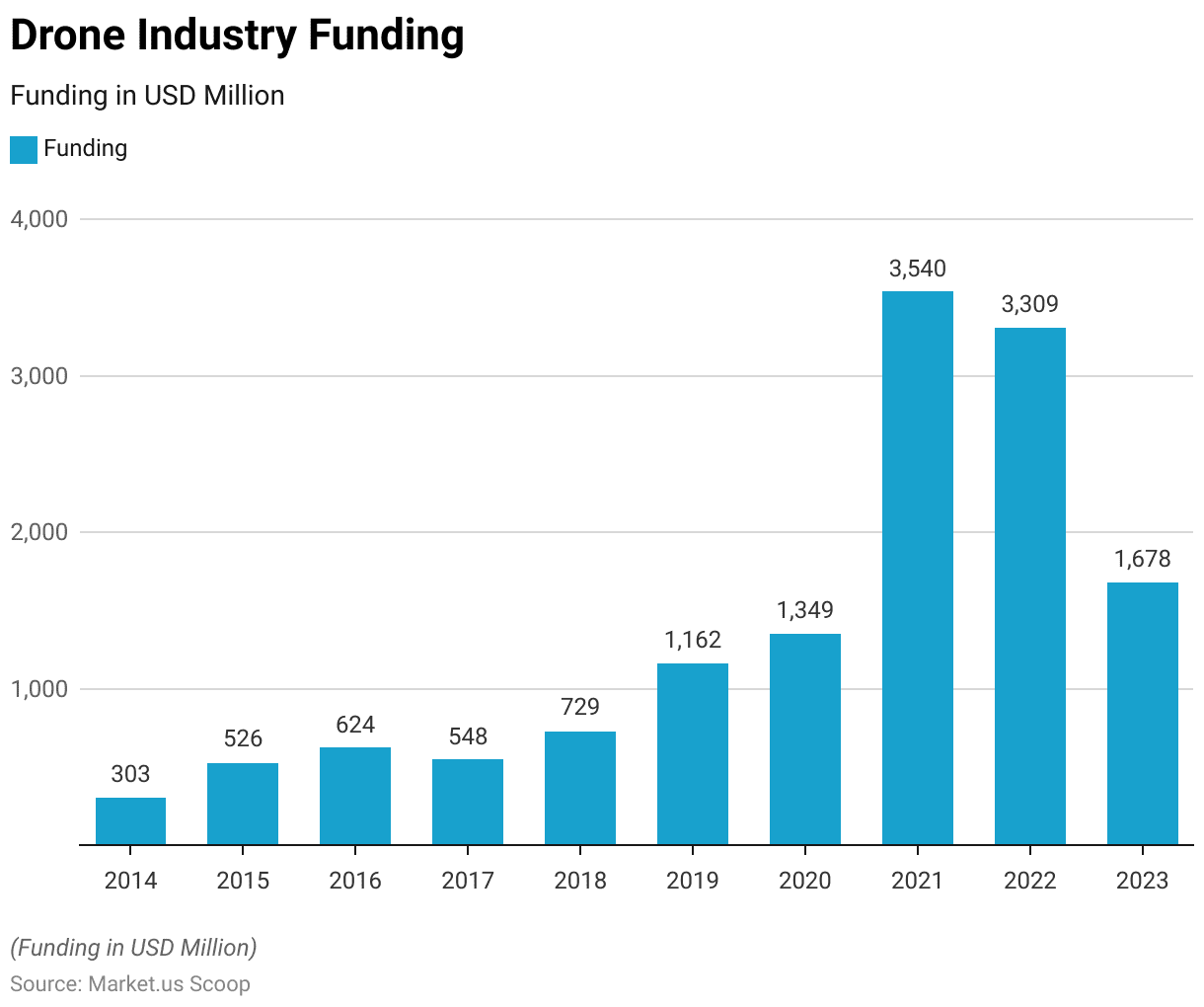
Investment and Research & Development
- By 2029, the U.S. military plans to allocate $2.7 billion toward drone research and development and $3.3 billion towards procurement. These figures may escalate further, considering potential additional funding earmarked for classified projects.
- These investments will bolster the creation and acquisition of military drones utilized for a range of purposes. Including intelligence gathering, surveillance, search-and-rescue operations, payload and weapon delivery, and combat missions. They aim to furnish the U.S. military with a strategic edge while mitigating risks of casualties among troops.
- The U.S. Army has utilized diverse drone technologies, among them General Atomics’ MQ-20 Avenger (Predator C). Renowned for its capacity to reach speeds of up to 400 knots, ascend over 50,000 feet, and endure flight for more than 20 hours.
- The U.S. Department of Defense (DoD) oversees a fleet exceeding 11,000 drones. Including the RQ-4 Global Hawk, employed for both domestic training exercises and international missions.
- Northrop Grumman developed the X-47B under the U.S. Navy’s Unmanned Combat Air System (UCAS) Carrier Demonstration initiative. This unmanned aerial vehicle was conceived to aid the Navy in exploring the prospects of carrier-based drone aviation.
(Source: National Defence Magazine, General Atomics Aeronautical, U.S. Department of Defense, Northrop Grumman)
Recent Developments
Acquisitions and Mergers:
- EagleView acquires Spookfish: In 2023, EagleView Technologies, a leading aerial imaging company, acquired Spookfish, an Australian aerial imaging firm, for $90 million. This acquisition strengthens EagleView’s capabilities in capturing high-resolution aerial images, enabling better data for industries like insurance, agriculture, and government.
- DroneDeploy acquires Rocos: In early 2024, DroneDeploy, a provider of drone-based aerial imaging and software, acquired Rocos, a company specializing in robotic automation, for $50 million. This acquisition is aimed at enhancing DroneDeploy’s aerial imaging software with automation features. Making it easier to capture and analyze images at scale.
New Product Launches:
- Parrot launches ANAFI Ai drone with 4G connectivity: In mid-2023, Parrot, a leading drone manufacturer, launched the ANAFI Ai drone, equipped with 4G connectivity for real-time aerial imaging and data transmission. This drone targets sectors like agriculture, construction, and mapping, offering users the ability to capture high-quality images with reduced latency.
- DJI introduces the Mavic 3 Enterprise series: In early 2024, DJI launched the Mavic 3 Enterprise series, designed for professional aerial imaging applications. The new drone features a 20MP camera with a mechanical shutter, capable of capturing ultra-high-resolution images for industries like surveying, real estate, and infrastructure management.
Funding:
- Skycatch secures $70 million for aerial mapping solutions: In 2023, Skycatch, a leader in aerial imaging and mapping, raised $70 million in a Series D funding round. The investment will be used to enhance its drone-based imaging and 3D mapping solutions, focusing on industries like construction and mining.
- PrecisionHawk raises $100 million to expand aerial imaging services: In late 2023, PrecisionHawk, an aerial data and drone technology company, secured $100 million in funding to scale its imaging services. The funds will be allocated to expand their AI-driven image analysis and drone fleet management capabilities.
Technological Advancements:
- AI-powered image analysis: By 2025, 50% of aerial imaging platforms are expected to incorporate AI-driven image processing, enabling faster and more accurate data analysis for industries like agriculture, real estate, and disaster management.
- Integration of multispectral imaging: Multispectral imaging is becoming more common in aerial imaging. By 2026, 35% of aerial imaging drones will feature multispectral sensors to provide more detailed data for sectors like environmental monitoring and precision agriculture.
Conclusion
Aerial Imaging Statistics – In conclusion, the aerial imaging sector is experiencing rapid growth and innovation, fueled by increasing demand and advancements in technology.
Companies such as DJI and Skydio are at the forefront of introducing cutting-edge solutions to meet the diverse needs of industries worldwide.
With applications ranging from agriculture to public safety. Aerial imaging plays a vital role in providing valuable insights and enhancing decision-making processes.
Collaboration among industry players and government agencies is driving further innovation and adoption of drone technology.
As regulations evolve, we anticipate continued expansion of aerial imaging solutions. Revolutionizing various sectors and shaping the future of how we interact with our environment.
FAQs
Aerial imaging involves capturing images of the Earth’s surface from an elevated position. Typically these drones or aircraft are equipped with cameras.
Aerial imaging is utilized across a wide range of industries, including agriculture, real estate, construction, environmental monitoring, urban planning, infrastructure inspection, and public safety.
Aerial imaging involves capturing images from drones or aircraft flying at lower altitudes. Providing higher resolution and more detailed images compared to satellite imagery. Aerial imaging can also be conducted on-demand and with greater flexibility. Whereas satellite imagery is subject to predetermined orbital paths and may be affected by weather conditions.
Various types of cameras can be used for aerial imaging, including RGB (Red, Green, Blue) cameras, multispectral cameras, thermal cameras, and LiDAR (Light Detection and Ranging) sensors. Each type of camera serves different purposes and can capture different types of data.
Yes, regulations for aerial imaging vary by country and jurisdiction. In many places, drones used for commercial aerial imaging purposes must be registered, and operators may need to obtain specific licenses or certifications. Additionally, there are often restrictions on where drones can fly and how they can be used to ensure safety and privacy.
Discuss your needs with our analyst
Please share your requirements with more details so our analyst can check if they can solve your problem(s)



